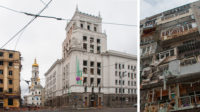Architecture Students Help Rebuild Greensburg

Architecture Students Help Rebuild Greensburg
Kansas State University students hope to dot Greensburg, Kansas, with pods that embody ecologically responsible design.
Photos courtesy Greensburg Cubed

Architecture Students Help Rebuild Greensburg
Kansas State University students hope to dot Greensburg, Kansas, with pods that embody ecologically responsible design.
Photos courtesy Greensburg Cubed

Architecture Students Help Rebuild Greensburg
Kansas State University students hope to dot Greensburg, Kansas, with pods that embody ecologically responsible design.
Photos courtesy Greensburg Cubed

Architecture Students Help Rebuild Greensburg
Kansas State University students hope to dot Greensburg, Kansas, with pods that embody ecologically responsible design.
Photos courtesy Greensburg Cubed

Architecture Students Help Rebuild Greensburg
Kansas State University students hope to dot Greensburg, Kansas, with pods that embody ecologically responsible design.
Photos courtesy Greensburg Cubed

Architecture Students Help Rebuild Greensburg
Kansas State University students hope to dot Greensburg, Kansas, with pods that embody ecologically responsible design.
Photos courtesy Greensburg Cubed

Architecture Students Help Rebuild Greensburg
Kansas State University students hope to dot Greensburg, Kansas, with pods that embody ecologically responsible design.
Photos courtesy Greensburg Cubed

Architecture Students Help Rebuild Greensburg
Kansas State University students hope to dot Greensburg, Kansas, with pods that embody ecologically responsible design.
Photos courtesy Greensburg Cubed

Architecture Students Help Rebuild Greensburg
Kansas State University students hope to dot Greensburg, Kansas, with pods that embody ecologically responsible design.
Photos courtesy Greensburg Cubed

Architecture Students Help Rebuild Greensburg
Kansas State University students hope to dot Greensburg, Kansas, with pods that embody ecologically responsible design.
Photos courtesy Greensburg Cubed





Post a comment to this article
Report Abusive Comment